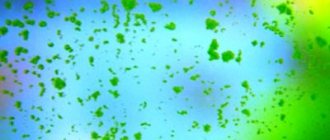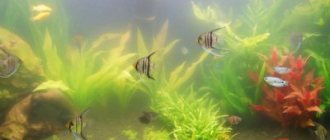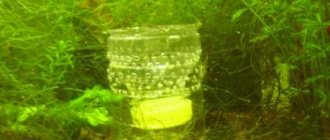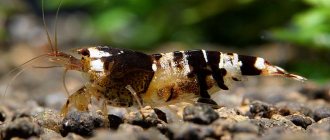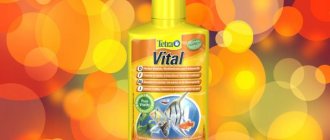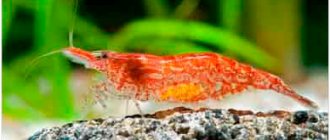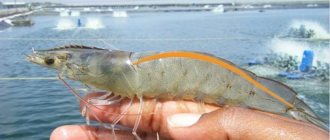Freshwater shrimp have gained enormous popularity over the past few years. It all started in 2000, with the appearance on the market of neocardina shrimp and their brighter variation - cherry shrimp, and then began to develop like an avalanche. Now new species of shrimp appear almost every month, but just recently we had never heard of them.
Among them, crystal shrimp (lat. Caridina cf. cantonensis) stand out as one of the most diverse species in color, presented in dozens of variants. But it is quite demanding in terms of keeping parameters, unlike its relatives from the genus Neocaridina (cherry shrimp and ordinary neocardina).
Classification of red crystal shrimp
As a result of selection, it was possible not only to develop a new species, Caridina cantonensis sp. Crystal Red, but also to achieve a variety of color options for its representatives. As a result, specialists and breeders needed a system for separating these aquatic organisms based on their oxar.
There are 2 classifications of red crystal shrimp - German and Japanese. Both separate individuals by the number of white and red spots, their location and brightness. The highest class shrimp have the brightest color, where white predominates over red. Consider the Japanese classification system:
- C - most of the body is red, the color is not very saturated, there are transparent areas. The location of white or transparent areas is random.
- B - these shrimp have more white and light translucent areas than representatives of class C. The color pattern is also random.
- A - individuals from this group have 3-4 white stripes on their red body. The rostrum and the back of the tail are distinguished by a scarlet tint. The peculiarity of this color form is that the red areas of the shrimp’s body are often translucent.
- S - in color, representatives of this class are similar to the A-class, but have a more opaque body with bright and saturated red areas.
- S+ - red and white areas are combined into specific patterns, there are clear transitions between colors without translucent areas. There must be 4 white stripes. There are 2 common patterns: V-Type and Tiger Tooth. Shrimp from the first group have a red spot on their back that resembles the letter V, while individuals from the second group have two red stripes, separated by one white stripe and shaped like long fangs.
- SS - in these shrimps the white body color is already beginning to predominate, and according to the location and shape of the red areas, individuals are divided into 3 more subgroups:
- Hinomaru - with a round spot in the cephalothorax area.
- No-entry Hinomaru - a round spot on the cephalothorax is divided by a white stripe, reminiscent of the special mark from which the color form of the shrimp gets its name.
- Double Hinomaru - these shrimp have one round red area located on the cephalothorax, the second closer to the tail.
- SSS - most of the shrimp's body is white, bright red spots are present only on the cephalothorax. In this class there are additionally 2 subgroups:
- Mosura Crown - a red spot on the cephalothorax takes the shape of a crown.
- Mosura Flower - a red spot on the cephalothorax shaped like a flower.
- SSS+, also known as SSSS - only red shrimp were used to obtain this color form. The animal's legs are also distinguished by their red color. The patterns may not differ from representatives of the S-SSS classes, but they are characterized by more saturated shades of red and bright white.
Compatibility
Amano shrimp are absolutely peaceful creatures that are perfect for keeping in community aquariums with peaceful fish species. You can choose cockerels, gouramis, barbs, and viviparous fish as neighbors. They get along well with calm catfish: corydoras and ancistrus.
Since shrimp are not large in size, keeping them with large fish or predators is strictly not recommended so that the “crustaceans” do not become their prey. Even relatively calm angelfish will not mind snacking on young shrimp.
When kept with peaceful fish, you can sometimes observe how amusingly Amano shrimp take food from each other and from the fish.
Amano shrimp get along well with peaceful fish species
Spreading
The red crystal shrimp is a selective species, so it cannot be found in nature. And the ancestors of this species live mainly in the reservoirs of China, Taiwan and Japan.
The wild shrimp Caridina cantonensis used to breed Crystal Red prefers very slow-moving, acidic water.
The latter becomes so due to the large amount of fallen leaves and other decaying organic matter. Thanks to this water composition, shrimp are protected from fungi, viruses and bacteria.
Habitat in nature
The homeland of shrimp is China and Japan, but the natural form is not as bright as those that live in our aquariums. Their body is transparent, and there are brown-black or white stripes along it.
There is an option with a transparent body and thin, dark stripes, the so-called tiger shrimp. However, color options vary greatly not only depending on the habitat, but even on the body of water.
Savages are quite unpretentious, although they are not brightly colored, and are suitable even for beginners.
Maintenance and care
Caridina cantonensis sp.
Crystal Red is quite demanding in terms of conditions of detention. The fact is that as a result of selection, with an increase in the brightness and saturation of the color of shrimp, their immunity was simultaneously weakened.
And the higher the class of the red crystal, the more attention it requires. Only experienced aquarists can handle such pets.
When keeping red crystal shrimp, you must follow several rules.
- Use a short and wide vessel as a shrimp tank. The top of the aquarium must be closed with a lid so that the shrimp do not crawl out. The recommended container volume is from 15-20 liters for a group of 4 individuals.
- Check the chemical composition of the water regularly. Caridina cantonensis sp. Crystal Red is too sensitive to hardness levels. In very soft water, they will not be able to get enough calcium, which is why they will not be able to build a new shell. And with increased rigidity, they will either not be able to reproduce or will die altogether.
- Place fine-grained soil made of sand, pebbles or small stones without sharp chips in the aquarium.
- There should be plenty of hiding places in the aquarium. Porous stones and grottoes are suitable, it is advisable to add more vegetation. It is important that aquatic plants are low. You can use mosses, low ferns, carpet algae, and liverworts.
- Lighting is selected according to the plants. The shrimp themselves are not demanding, the main thing is that the daylight hours do not last more than 14 hours.
Water parameters for ideal maintenance
Red crystal shrimp are very sensitive to water conditions. Under no circumstances should strong and sudden changes in hydrochemical parameters be allowed. The following values are considered optimal:
- temperatures - 22-24ºС;
- general hardness - 3-5º, representatives of the lower classes can survive if the indicators increase to 7-13;
- carbonate hardness - up to 2º;
- acid-base reaction of water - 6.5-7.3, for lower classes an increase to 7.5 is permissible.
To ensure that the water is always clean and fresh, it is necessary to replace about a third of the volume of aquarium liquid every 10-14 days.
Tap water cannot be used for replacement due to its high hardness. Liquid after osmosis is also not suitable because it contains too few minerals. It is best to use a mixture of settled tap water and treated by osmosis.
The aquarium must have a high-performance filter and an aerator. Additionally, it is recommended to install a thermostat to maintain a constant water temperature. If the liquid is too warm, the red crystal shrimp will die quickly. When the temperature is too low, animals become pale and lethargic and stop reproducing.
What to feed
Red crystal shrimp are detritivores. Their food is decomposed organic matter. When observing shrimp, you can notice that they are looking for food on the surface of decorations and aquatic plants located in the aquarium.
Caridina cantonensis sp. Crystal Red can live for 1-2 days without food without harm to health. And experts separately note that it is better not to feed shrimp too much than to overfeed it. Otherwise, your pets will have health problems.
- When preparing a diet, it is necessary to take into account that red crystals are unable to digest large amounts of protein foods. Also, excess protein leads to more frequent molting. If there is not enough “building material” to build a new shell, this can lead to the death of the shrimp.
- Therefore, 80-90% of the feed should come from plant ingredients. From protein products, you can give bloodworms or fish fillets in small quantities. And as a source of fiber - vegetables and herbs. Cucumbers, zucchini, and spinach are suitable.
Additionally, you can use specialized dry food. For example, Tetra WaferMix, which is suitable for feeding bottom aquatic organisms, NovoPrawn from JBL or ShrimpsNatural from sera.
Nutrition
The basis of nutrition for Crystals is algae. Healthy shrimp constantly move around the aquarium in search of food. If there are a large number of plants, they will most likely have enough food, otherwise they can be fed with specialized high-quality plant-based food, and less often treated with frozen cyclops, daphnia and brine shrimp. They happily eat spinach, Indian almond, oak, apple, peach, ash, hazel and mulberry leaves, pieces of fruit and vegetables. It is advisable to rinse the latter well and boil a little to get rid of the nitrates they contain. You can place driftwood from willow and alder in the shrimp tank and the crystals will eat up the decomposed top layer with gusto.
Red and black crystal shrimp, food.
You cannot overfeed with protein foods; shrimp are simply not able to digest and absorb them in large quantities. However, any excess food, which should be eaten within 30-60 minutes, is harmful to them. Residues are removed from the aquarium to avoid water contamination.
Poor nutrition leads to the loss of the white color of the Crystals, which becomes transparent or acquires a grayish-yellow tint. Feeds with minerals and iron, on the contrary, help maintain a rich, contrasting color.
Reproduction
Breeding shrimp is not difficult for an experienced aquarist. And if you then sell the young animals, your investment in pets will pay off fairly quickly. For reproduction, it is enough to have different sexes. Shrimp reach sexual maturity at the age of 4-6 months, when they reach 2 cm in length.
It is not difficult to distinguish a female from a male. Female individuals are larger, with a full abdomen and a curved underbelly.
When molting begins, the female releases pheromones into the water, by which the male begins to search for her. After fertilization, the female carries the eggs under her abdomen on pseudopods.
The incubation period lasts 20-30 days, then young shrimp hatch from the eggs. Young animals differ from adults only in size. From birth, small red crystals are able to move independently and look for food.
Shedding
Like most other living organisms, crustaceans are constantly growing. But since they are invertebrates, the role of their skeleton is played by the shell, which does not grow with the shrimp. When a shrimp becomes too large for its exoskeleton, it is time to shed it, a process called molting.
Juvenile crustaceans shed more often because they grow faster, and molting once every 4-5 days is normal for them. Adults shed much less frequently - once every 1.5-2 months.
The shell consists of chitin, and the building material for it accumulates throughout the life of the crustacean. If there are insufficient nutrients accumulated, or molting occurs prematurely, this is fraught with complications or death.
Sometimes shrimp undergo unscheduled molting as a reaction to changing environmental conditions. It is especially dangerous for recently moulted individuals or for pregnant females.
As a rule, the female moults before mating and after giving birth to offspring. If she sheds her shell during pregnancy, the gestating eggs will certainly die.
Shrimp molt quite quickly, but recovery is a long and complex process for them. A rapidly molted individual quickly hides in reliable shelters, since its skin will be very soft and tender over the next 1.5-2 days. During this time, the crustacean is at rest and does not feed, and it is during this period that it grows. Even snails, and various fish even more so, can pose a danger to such a shrimp.
Sometimes it is useful to make various calcium supplements by placing calcium carbonate tablets or chalk on the bottom. If the crystals actively eat it, then this element is not enough in their body.
It is better to ensure that there is a certain amount of sand in the aquarium, since after molting, arthropods lose the internal lining of the statocyst, the organ of balance. To navigate in space, shrimp need grains of sand, which irritate the hairs inside this pocket.
Editorial: Echinodorus schluthera
A variety of lost organs, such as claws, antennae and legs, are gradually restored during molts.
Determination of gender
In childhood and adolescence it is very difficult to determine gender. Once you reach adulthood, you will be able to tell the difference between the sexes. The female is easy to identify as she is larger and has a rounded abdomen. Some believe that males and females differ in color, but this is not always quite noticeable. It is easier to identify females by their abdomen and size. The saddle of females is almost impossible to see because of their color, but you can try to see it: it will be dark brown. In the photo below, notice how the female’s abdomen is rounded.
Conclusion from all of the above
The lifespan of a Red Crystal in an aquarium with good care is one and a half years. By following simple rules, you can completely return all your cash investments to your pocket within six months. What to do with the grown young animals? Every person has the right to do as he thinks. Of course, you can keep them and enjoy the beauty of living crystals, or you can even sell them, which is the most profitable solution. The price of one such crustacean, for example, S-class, is approximately 120 rubles, and the cost of a large SSS-class individual starts from 300 rubles. In conclusion, I would like to focus the reader on the diversity of the aquarium world. You don’t have to have a half-ton aquarium at home, but it’s easy to become a shrimp breeder!!! Try it yourself, because such extraordinary beauty is worthy of becoming a decoration for your home aquarium! And if you have children in your family, they will not be more happy to watch the life of these unusual animals and care for them with love.
Post Views: 3,345
Feeding
For feeding crystals, there are many specialized commercial products that will provide the little inhabitants of the aquarium with everything they need, but any fish product, both flakes and frozen, will be suitable for this. If the aquarium is well planted with live plants, and especially on nutritious soil, shrimp will always find something to eat. In addition, fresh cucumbers, blanched spinach and zucchini, ketapang leaves (which will also help lower the pH of the water) and other vegetables are suitable.
Feeding once a day is enough.
